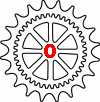|
Calculate new wheel position based on existing chain or belt length
There are 2 approaches to determine what needs to happen to your chain/belt and wheel position when changing sprocket sizes:
-
Use a semi-fixed position of the rear wheel (hence a semi-fixed sprocket distance) and calculate needed links.
-
Use the current chain and it's current number of links to calculate the new position of the rear wheel after changing sprocket sizes.
For help on the 1st approach follow this link: Chain Links Calculator for Generic Final Drive with new chain
The 'Loaded Bike: Effect of Final Drive changes on links & wheel position' part
of the main page is
for using the second approach: loading a bike
from the database, changing Current and Custom setup and assume the
current chain with it's current number of links will be used to
calculate the new position of the rear wheel when changing sprocket
sizes.
So in this case you initially want to check if you can still use your current chain after changing sprockets sizes.
In this part the calculator will calculate the new position of your rear wheel after changing the sprockets. This position is being
compared to the Stock and Current position of the rear wheel. That way you can check on your bike if the new position is feasible or not.
That depens on how much room is still left to tighten or loosen your chain by moving your rear wheel backward or forwards from its current postion.
So you need to check on your bike if that room is available or not.
The calculator uses the loaded Stock chain details and also the Current and Custom chain details you entered to calculate the Stock, Current and Custom rear wheel positions.
To be able to compare them and determine how much the rear wheel needs to moved, for the Stock setup a new chain
(with 0% wear) is assumed to be used. For Current and Custom setup
your current, used chain (with 0.5% wear) is assumed to be used.
A new (unused) chain has not stretched yet. Your Current chain which is assumed to be also your Custom chain, is probably not new and has probably suffered some 'stretched' already.
That is why the calculator also offers the option to enter the amount of 'stretch' or actually 'chain wear' in % for your Current and Custom chains.
Motorcycle chains will wear depending on quality, chain type, maintenance, bike power and riding style. This wear is revealed as 'stretch' but actually the chain does not
stretch, it is actually the clearance between the bushings and the links that
wear out and gets bigger over time. When that clearance is too big, a chain
needs to be replaced. As a rule of thumb O-ring chains need to be replaced arround 1% 'stretch' and Non-O-ring chains arround 2%
The default GC setting for 'Current' and ' Custom' chain wear is assuming the chain to be an O-ring chain which is at it's 'half-life' so has 0,5% wear.
If you have a relatively new chain you can adjust is downward (or even to 0% is it is a new chain) of if an old chain already, adjust upwards.
There is a method to determine the actual amount of 'stretch' or 'wear' by
accurately measuring 16 links, counting both roller and pin links. Comparing the
measured length to a new chain with theoretical 0% 'wear' will indicate the wear
of your current chain as follows:
Chain Wear Percentage = (Measured length 16
links - ( 16 * Chain Pitch)) / ( 16 * Chain Pitch / 100)
Example in Inch: Measured 16 links = 10.09", Chain Type = 525 (so pitch new =
0.625")
Wear Percentage = (10.09- (16 * 0.625)) / (16 * 0.625 / 100) = 0.90%
Example in Milimeter: Measured 16 links = 256.3 mm, Chain Type = 525 (so
putch new = 15.875 mm)
Wear Percentage = (256.3 - (16 * 15.875) / (16
* 15.875 / 100) = 0.90%
As this calculater calculates the result for 3 setups, for it to work, a bike needs to be loaded from the GC
database. After loading your bike from the
database you need to:
1) Update Current Setup to reflect your current bike
2) Update Custom
Setup to reflect what you are considering to change and
3) If known, adjust the chain wear in % for Current and Custom Setup. Initialy Chain Wear is
set at 0.5%.
First, based on the number of links and the entered Chain pitch, the theoretical
chain
length will be calculated and is shown in table "Current Chain
Loaded Bike: Effect of sprocket & chain changes".
For Belt drive bikes the same can be done to calculate the total belt
lenght, in this case also the pitch needs to be available and instead of
links you need to fill out the numer of teeth of the belt.
This information is not of much use but it is used to calculate the necessary sprocket distance later on.

Remark: This shown
chain length does NOT change here when changing sprockets !
In this table (initialy) it is assumed
that you keep your current chain (or belt) with its current number of links
(teeth if belt) and hence its current length.
The length of your current chain
(or belt) is used to calculate the
new resulting
sprocket distance as that DOES change when changing sprockets. See next Help
page.
Next: Calculate sprocket distance based on total chain length and sprocket combination
Back to Gearing
Commander main page
|







